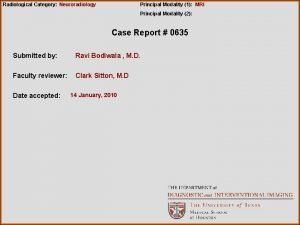Radiological Category Neuroradiology Principal Modality 1 MRI Principal











- Slides: 11

Radiological Category: Neuroradiology Principal Modality (1): MRI Principal Modality (2): None Case Report #0192 Submitted by: Michele Lesslie, DO Faculty reviewer: Leo Hochhauser, MD Date accepted: 8 March 2005

Case History This is a 74 year old Caucasian female with a visual field deficit, especially with downward gaze.

Radiological Presentations Axial T 1 -weighted MRI of Orbits without Contrast

Radiological Presentations Axial T 2 -weighted MRI of Orbits

Radiological Presentations Axial T 1 -weighted MRI of Orbits with Contrast

Radiological Presentations Coronal T 1 -weighted MRI of Orbits with Contrast

Test Your Diagnosis Which one of the following is your choice for the appropriate diagnosis? After your selection, go to next page. • Intraocular Foreign Body • Intraocular Lymphoma • Intraocular Melanoma • Vitreous Hemorrhage • Retinoblastoma

Findings and Differentials Findings: Image 1: Axial T 1 -weighted MRI of the orbit demonstrates a sharply defined mass lesion within the nasal aspect of the left globe. It is high in T 1 signal on this noncontrast image. Image 2: The mass is low in T 2 signal intensity. Image 3: The mass enhances with contrast on the axial T 1 -weighted image and is also shown in Image 4 in the coronal T 1 plane. Differentials: Intraocular foreign body Vitreous hemorrhage Intraocular melanoma Ocular Lymphoma

Discussion • Melanoma is the most common primary malignant intraocular tumor and the second most common type of primary malignant melanoma in the body. However, it is still a tumor that is not frequently encountered. • Intraocular melanomas are usually asymptomatic for prolonged periods of time, and may be found incidentally during routine ophthalmoscopy. When symptomatic, they might present with the following symptoms: blurred visual acuity, painless and progressive visual field loss and vitreous floaters. Occasionally, intraocular melanomas may produce severe ocular pain. • Intraocular melanoma usually results in partial or total visual loss in the affected eye. This may be caused by either tumor destruction of ocular structures or the treatment used. Approximately 30 -50% of patients with intraocular melanoma will die within 10 years, usually secondary to distant metastases. The liver is the most common site of metastatic involvement.

Discussion • The diagnosis is usually established by clinical examination and ocular ultrasound. • CT scan of the globe and orbit with contrast may be useful to see extraocular extension and may help differentiate between choroidal or retinal detachment and a solid tumor. Intraocular melanoma shows enhancement with contrast, whereas exudation does not. CT is also very sensitive for detecting calcium, a feature of some tumors that are different than melanoma (characteristically choroidal osteoma or retinoblastoma). • On MRI of the globe and orbit, melanomas are hyperintense on T 1, due to melanin content, and enhance with contrast administration. They are hypointense on T 2. MRI also can be used to determine extrascleral extension of the melanoma and distinguish surrounding fluid from the tumor.

Diagnosis Intraocular Melanoma
 Ohsu neuroradiology
Ohsu neuroradiology Aerohive erate
Aerohive erate National radiological emergency preparedness conference
National radiological emergency preparedness conference Radiological dispersal device
Radiological dispersal device Tennessee division of radiological health
Tennessee division of radiological health Center for devices and radiological health
Center for devices and radiological health Mri principal
Mri principal Lexical vs auxiliary verbs
Lexical vs auxiliary verbs High modality examples
High modality examples Pacs modality workstation
Pacs modality workstation Diplode
Diplode Tom arbuthnot
Tom arbuthnot




















